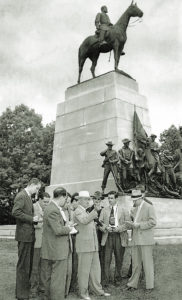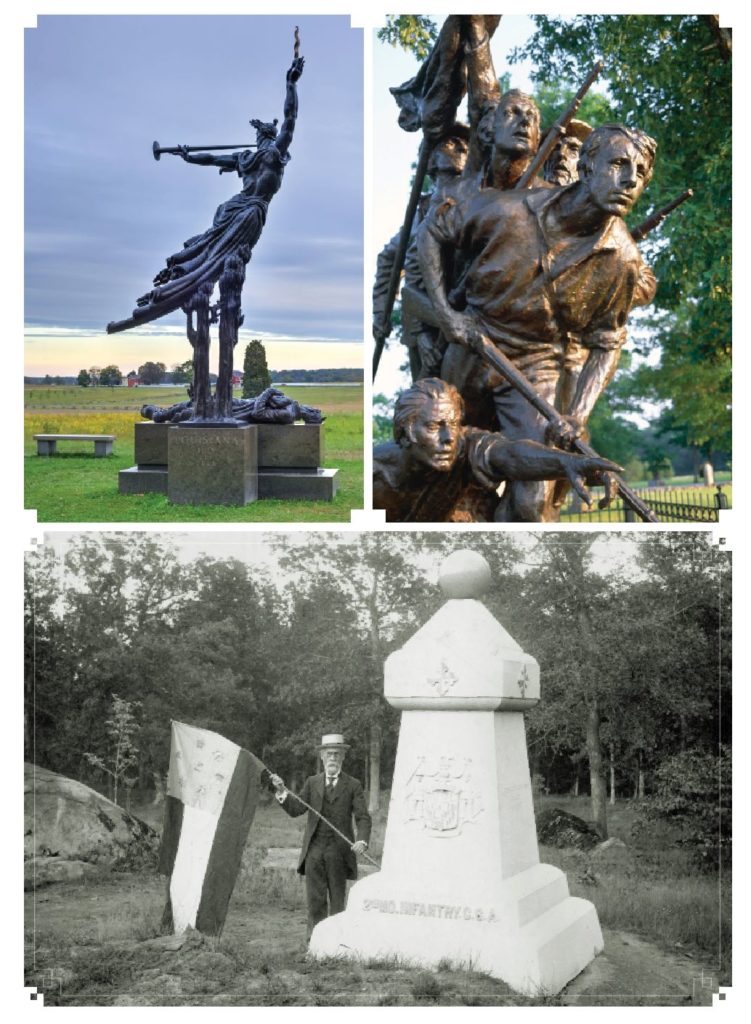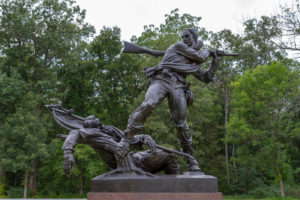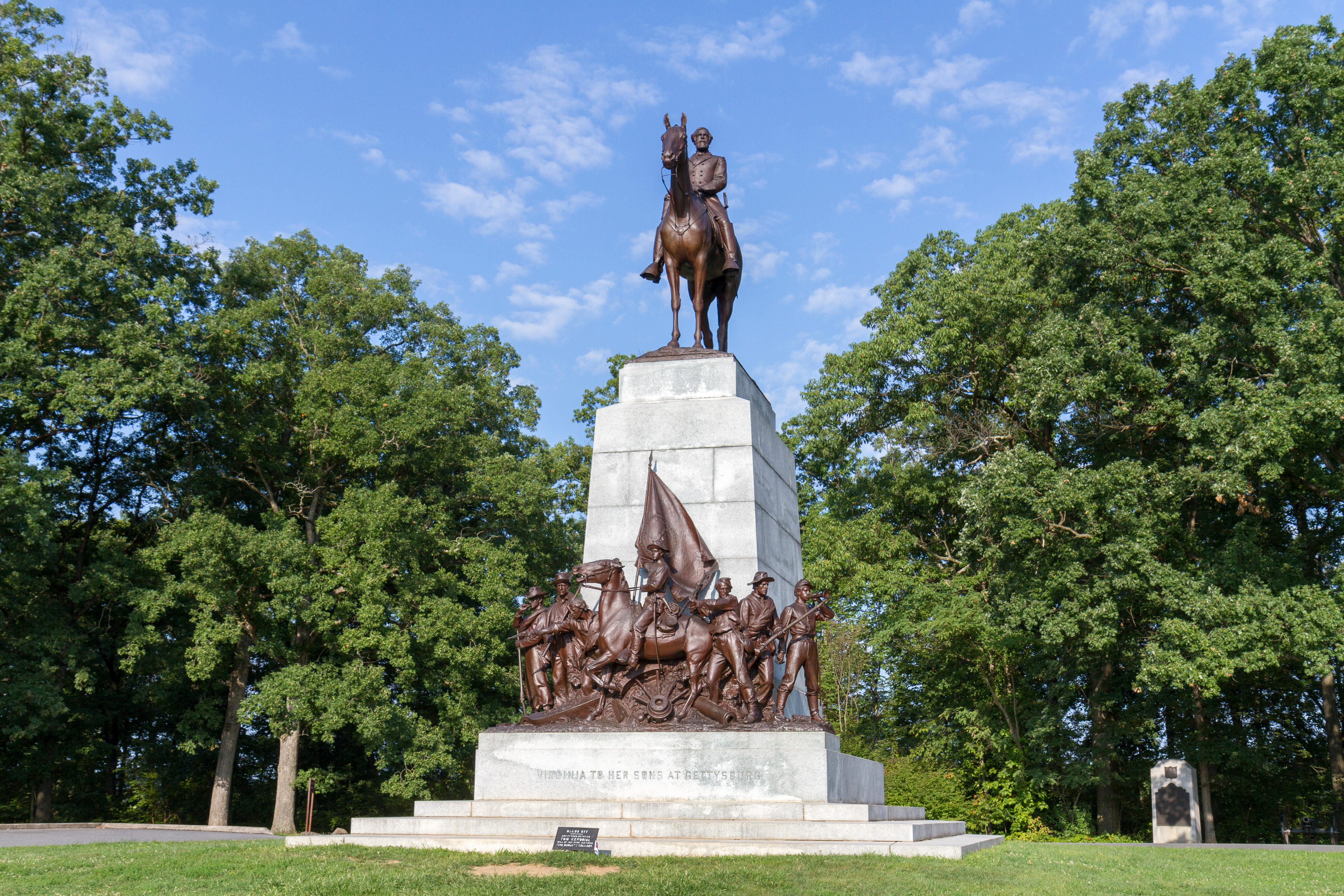Prominent historian Gary W. Gallagher argues how Confederate monuments on the Gettysburg battlefield can serve as invaluable teaching tools.
[dropcap]V[/dropcap]isiting Gettysburg National Military Park should be unsettling. The site exists, after all, because of a breathtaking failure of the nation’s electoral system in 1860. Powerful members of Southern society thought Republican victory menaced the long-term viability of slavery and refused to accept the verdict of the ballot box. They dismembered the republic and opened the way for a war whose memory grappled with massive human loss, emancipation’s vast political and social consequences, and anger that lingered for years. As the nation continues to struggle with that memory, a sound understanding of the war and its legacies demands a level of discomfort. The presence of Confederate monuments at Gettysburg will upset some visitors, but that is a price worth paying to protect a valuable and instructive memorial landscape.
The need to accept discomfort merits attention because heated debates regarding the Civil War’s memorial landscape have included calls to remove Confederate monuments at Gettysburg. These debates on social media, in the U.S. House of Representatives, and elsewhere raise the question of how best to handle the conflict’s deeply, and sometimes violently, contested memory. No other era in our history features the unfathomable complexity of political, social, and constitutional fracturing that sundered the republic and unleashed frightful slaughter. Through 12 years of Reconstruction, decades of Jim Crow rule in the South, the Civil Rights movement of the mid-20th Century, and beyond, conflicting memories of the Civil War affected national politics and culture.

Gettysburg National Military Park offers superb opportunities to study how the war has been remembered. The battlefield yields insights into memory traditions developed by both the war’s winners and losers. Because most Americans have little or no appreciation for the difference between history and memory, between what actually happened, and how events have been interpreted by different groups at different times, the memorials at Gettysburg hold substantial value as educational tools. As part of this commemorative landscape, which developed over more than a century and a quarter and retains great historical integrity, Confederate monuments should be woven into a touring narrative devoted to how Americans have recalled their defining national trauma. The addition of contextual waysides would enhance the quality of the educational experience by helping visitors recognize ideas and themes associated with various streams of memory.
Before moving on, I will acknowledge that some critics have questioned the educational value of monuments. Education cannot reach everyone, they insist, and in the meantime monuments can offend some people—so we should take them down to make everyone feel safe. These arguments are misguided. Education is not just a convenient rationalization in support of retaining some elements of the memorial landscape; it is the only hope for a serious, productive engagement with our past—warts and all. And no education of any value depends on selective erasure of troubling dimensions of America’s story.
History should not be turned into a simplistic morality play juxtaposing good and evil, heroes and villains, and contrived to serve current political goals. A memory tour at Gettysburg would illuminate controversies relating to secession, slavery, and reconciliation. It is also important to note that Confederate monuments in a national battlefield park, where professional staff are entrusted with preserving and interpreting the materials of Civil War history and memorialization, should not be declared identical to those in front of civic buildings, in public parks, or on campuses (the latter raise a set of their own particular issues).
[dropcap]T[/dropcap]he Gettysburg park’s website places the number of monuments, markers, and memorials at 1,328, just more than 200 of which (15 percent) can be designated as Confederate. A few deal with soldiers from both sides. The majority of Confederate markers give brigade and battery positions, strengths, and casualties. Others do the same for divisions and corps headquarters and a few regiments. Purely informational, these markers seem ill-suited to provoke outrage.
The most visible and controversial Confederate monuments are the 11 dedicated to individual states. They represent, in stone and bronze along Seminary Ridge, tangible evidence of history’s sharp and uncomfortable edges. They evoke the Confederate republic established to maintain a slaveholding society—and most especially the Rebel armies that pushed the United States to the precipice of disaster. Their presence forces us to acknowledge the messy interplay between history and memory. Without them, visitors might wonder why the Army of the Potomac went to Gettysburg and why more than a thousand Union regimental and other monuments dot the surrounding fields, ridges, and woods.
A memory tour at Gettysburg should stress that Confederate memorialization proved controversial from the outset. In 1887, for example, a veteran of the 73rd Ohio Infantry spoke bluntly at a program in the National Cemetery: “I do not believe there is another nation in the civilized world that would permit a rebel monument to stand upon its soil for a single day, and I can see neither wisdom nor patriotism in building them here.” The earliest Confederate monument, to the 1st Maryland Infantry Battalion, went up in 1886, but with the designation “2nd MD. INFANTRY C.S.A.” carved on the front. The Gettysburg Battlefield Memorial Association mandated the change because two loyal units—1st Maryland Regiment, Potomac Home Brigade Volunteer Infantry, and 1st Maryland Eastern Shore Infantry—deserved precedence. All three monuments adorn the slope of Culp’s Hill, and visitors can see that “1 MD. CHANGED TO” has been carved in small letters just above “2nd MD. INFANTRY C.S.A.”—a lesson in disputed memory etched on a single piece of stone.
The imposing Virginia monument fits squarely within the Lost Cause tradition. It avoids the topic of slavery, a striking illustration of how memory can mask the reality of history. Its sparse text—“Virginia to Her Sons at Gettysburg”—conveys no political message, but Robert E. Lee, whose mounted figure gazes eastward toward Cemetery Ridge, carried enormous ideological weight among Lost Cause advocates and continues to be a flashpoint. A wayside should instruct visitors that by 1917, when the monument was dedicated, Lee had become a national hero for many Americans, central to a reconciliation memory that would witness, in 1925, a congressional resolution authorizing “restoration of the Lee Mansion in the Arlington National Cemetery” and a U.S. 50-cent piece featuring Lee and Stonewall Jackson. Previously, a statue of Lee had been placed in the U.S. Capitol’s Statuary Hall (a Virginia commission voted unanimously to remove it in July 2020).

The Alabama and North Carolina monuments focus on soldiers. The former, erected in 1933, bears the inscription “ALABAMIANS! Your Names Are Inscribed on Fames Immortal Scroll” and the latter, Gutzon Borglum’s sculpture of five Tar Heel infantrymen completed four years earlier, just the words “North Carolina.” A United Daughters of the Confederacy tablet, situated just west of Borglum’s grouping, echoes inscriptions on monuments to fallen Rebels across the South: “To the eternal glory of the North Carolina soldiers. Who on this battlefield displayed heroism unsurpassed sacrificing all in support of their cause.”
[dropcap]F[/dropcap]ive state monuments and the Memorial to the Soldiers and Sailors of the Confederacy were erected during the Civil War centennial. The monuments, a wayside should explain, coincided with some of the most famous episodes of the Civil Rights movement and passage of the Civil Rights Act of 1964 and the Voting Rights Act of 1965. The Soldiers and Sailors memorial casts Confederates as “Heroic defenders of their country,” while Georgia’s granite tribute allows the dead to speak for themselves: “We sleep here in obedience; When duty called, we came; When country called, we died.”
Texas and Arkansas chose to laud the “valor” and “devotion” of their Confederate soldiers with no allusion to states’ rights, and Florida presented a text that celebrates the Floridians’ “courage and devotion for the ideals in which they believed” and, in a gesture toward healing sectional wounds, adds a hope that “By their noble example of bravery and endurance, they enable us to meet with confidence any sacrifice which confronts us as Americans.”
South Carolina’s monument echoes the language of secession in its principal text. “That men of honor might forever know the responsibilities of freedom,” it reads, “Dedicated South Carolinians stood and were counted for their heritage and convictions. Abiding faith in the sacredness of States Rights provided their creed.” Unveiled on July 2, 1963, the monument invites consideration of statements at Gettysburg from two prominent politicians that same summer. Alabama Governor George Wallace claimed “South Carolina and Alabama stand for constitutional government,” in a speech during the ceremony for the South Carolina monument: “Millions throughout the nation look to the South to lead in the fight to restore constitutional rights and the rights of states and individuals.” On May 30, speaking in the National Cemetery, Vice President Lyndon B. Johnson addressed a very different legacy of the conflict. “Until justice is blind to color,” he said, “until education is unaware of race, until opportunity is unconcerned with the color of men’s skins, emancipation will be a proclamation but not a fact.”
Of the final three state monuments, Mississippi’s makes the strongest Lost Cause statement. The inscription trumpets the Mississippians’ “righteous cause” and how “To valor, they gave new dimensions of courage / To duty its noblest fulfillment / To posterity, the sacred heritage of honor.” Tennessee settled for the prosaic “Valor and courage were virtues of the three Tennessee regiments” and Louisiana the bare-bones “Louisiana July 1, 2, 3, 1863.”

A tour keyed to Gettysburg’s monuments also demonstrates how Lost Cause and reconciliation streams of memory sometimes unite. The Eternal Light Peace Memorial, dedicated on the 75th anniversary of the battle, sought to be “An enduring light to guide us in unity and friendship.” In his remarks that day, President Franklin D. Roosevelt praised Union and Confederate veterans alike. “All of them we honor,” he affirmed, “not asking under which flag they fought then—thankful that they stand together under one flag now.”
[dropcap]M[/dropcap]ore recently, a Maryland state monument from 1994 depicts two wounded soldiers, one Union and one Confederate, helping each other off the field. It “proudly honors” the state’s 3,000 sons in blue and gray “who fought at Gettysburg in defense of the causes they held so dear” and “symbolizes the aftermath of that battle and the war. Brothers again, Marylanders all.” In 2000, Delaware erected a monument just a few yards from Maryland’s to honor “all Delawareans who fought at Gettysburg, both Union and Confederate.” A short distance to the northeast, the 1993 Masonic memorial, with “Friend to Friend / A Brotherhood Undivided” chiseled on the base, shows Union Captain Henry H. Bingham succoring the mortally wounded Confederate Brig. Gen. Lewis A. Armistead. These reconciliationist sentiments remind Gettysburg visitors that, for most loyal citizens of the United States, restoration of the Union entailed welcoming former Rebels back into the fold.
Restoring the Union and pursuing genuine reconciliation, two linked but quite different processes, occurred while the generation that experienced the war established what became long-standing memory traditions. Union veterans tried to suppress or counter the Lost Cause, while former Confederates labored to disseminate their version of why 11 states seceded and what transpired during the war. The presence of Confederate monuments at Gettysburg, however disconcerting for some Americans, demonstrates that winners do not always control the memory of historical events and eras. All visitors to Gettysburg should keep that in mind as they contemplate the battlefield. ✯
Gary W. Gallagher is a member of the Civil War Times advisory board.





